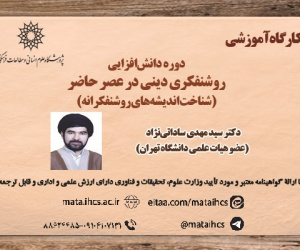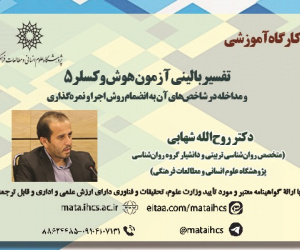ارزیابی خطر زلزله به روش هم پوشانی حسابی- وزنی برحسب شاخص پتانسیل زلزله (EPI)، جنوب غرب ایران (مقاله علمی وزارت علوم)
درجه علمی: نشریه علمی (وزارت علوم)
آرشیو
چکیده
مقدمه: در روش هم پوشانی حسابی وزنی برحسب شاخص پتانسیل زلزله (EPI) برای ارزیابی خطر لرزه ای هر منطقه، داده های تاریخی زلزله، توزیع زمین مکانی و بزرگای زمین لرزه های گذشته، زمین ساخت فعال (نوع و طول گسل)، تراکم گسل در واحد سطح، فاصله مکان تا گسل فعال، فاصله تا کانون زلزله، شیب و تغییرات توپوگرافی باید در نظر گرفته شود و لایه های مربوط با استفاده از GIS ایجاد شوند. این روش غیرارگودیک مشکلات روابط کاهندگی و بیان ورودی ها و خروجی های تحلیل خطر را حل می کند و در تهیه نقشه خطر زلزله مناطق وسیع جغرافیایی با پیشینه لرزه خیزی غنی، دقت بسیار مناسبی دارد. در این مطالعه، خطر زلزله در منطقه جنوب غرب ایران، در مربعی به ضلع 400 کیلومتر و با مرکزیت شهر بهبهان (طول °E2417/50 و عرض ° N5985/30) به روش هم پوشانی حسابی وزنی، برحسب شاخص پتانسیل زلزله ارزیابی شده است. روش شناسی: روش هم پوشانی حسابی وزنی برمبنای برهم نهی اطلاعات رتبه بندی شده مکانی، زمین شناسی و لرزه شناسی منطقه با وزن های از قبل تعیین شده قرار دارد. شاخص پتانسیل زلزله با استفاده از رابطه زیر محاسبه می شود: (1) در این معادله، EPI شاخص پتانسیل زلزله، DEM مدل رقومی ارتفاعی، Slope زاویه شیب برحسب درجه، Den_F چگالی گسل های فعال، Den_Ev تراکم کانون های زلزله، ML بزرگی زلزله، Dis_F فاصله تا گسل فعال، Dis_epi_ev فاصله تا کانون زلزله و i و j مختصات سلول (طول و عرض جغرافیایی) هستند. شناسایی مناطق دارای پتانسیل لرزه خیزی و ارزیابی خطرهای لرزه ای نیازمند در نظر گرفتن سهم تمامی پارامترها و ترکیب آنها، مطابق با اهمیت نسبی آنهاست. پس از تهیه نقشه های لازم، با توجه به لرزه خیزی منطقه ( توزیع کانون های زلزله، منابع لرزه زا و گسل های فعال) ، ویژگی های زمین ساختی ( سن لایه، زمین ساخت)، توپوگرافی منطقه ( مدل رقومی ارتفاعی) و شیب، EPI، تعیین می شود. منطقه مورد مطالعه (مربعی به ابعاد 400 کیلومتر و با مرکزیت بهبهان) از شیب تند شمال شرق با ارتفاع 4418، به شیب ملایم جنوب غرب (محدوده خلیج فارس) به ارتفاع 125- می رسد. نتایج و بحث: روش هم پوشانی حسابی وزنی برحسب شاخص پتانسیل زلزله (EPI) در جنوب غرب ایران انجام و نتایج به صورت نقشه و جدول ارائه شد. براساس نتایج، بخش هایی از شهرهای شرقی و شمالی استان خوزستان و شهرهای جنوب غرب استان چهارمحال بختیاری، کهگیلویه و بویراحمد و اصفهان و شهرهای شمالی استان بوشهر در مناطق EPI بالا و شهرهای گچساران، بهبهان، امیدیه، بهمئی، رامهرمز، باغ ملک، هفت گل، گتوند، اردل، کوهرنگ، فارسان و کبار در منطقه خطر بالا قرار می گیرند. در منطقه مورد مطالعه، شاخص پتانسیل زلزله در محدوده 55/1تا 75/6 متغیر است. میانگین برآوردشده مقدار EPI برابر با 415/4 و انحراف معیار برابر با 94/1 است. این مقادیر نشان دهنده تغییرات نسبتاً زیاد لرزه خیزی متوسط در منطقه است. همچنین جدول مقادیر EPI درمورد تمامی شهرهای استان خوزستان تخمین زده شد و شاخص پتانسیل زلزله هر شهرستان، براساس EPI، با شاخص لرزه خیزی استاندارد آیین نامه 2800 مقایسه شد. نتایج مقایسه در اغلب شهرها هم خوانی دارد و بیشتر بودن خطر بیان شده ازطریق استاندارد 2800 در موارد اختلافی بیان می کند که مقادیر استاندارد در جهت اطمینان قرار دارد. نتیجه گیری: روش هم پوشانی حسابی وزنی، برحسب شاخص پتانسیل زلزله (EPI)، روش جهانی جدیدی است که می توان آن را در ارزیابی خطر زلزله به روش غیرارگودیک به کار برد. براساس نتایج این روش، مقادیر ویرایش 4 استاندارد 2800 کفایت لازم برای طرح لرزه ای ساختمان ها را دارد.Seismic Hazard Assessment Using Arithmetic-Weighted Overlay Method Based on Earthquake Potential Index (EPI), Southwest of Iran
Introduction: In the arithmetic-weighted overlay method based on the earthquake potential index (EPI) to evaluate the seismic hazard of each region, historical earthquake data, spatial distribution and magnitude of past earthquakes, active tectonics (fault type and length), Fault density per earth surface, distance to active fault, distance to earthquake epicenters, slope, and topographical changes should be considered and corresponding layers are be created using GIS. This non-ergodic method solves the problems of attenuation relations and expression of inputs and outputs of hazard. Especially the method is very useful in preparing seismic hazard maps of large geographical areas with a rich history of seismic events. in This paper, the seismic hazard analysis for the southwestern region of Iran was conducted within a 400 km square centered on Behbahan city (located at longitude 50.2417° and latitude 30. 5985 ° N) using the arithmetic-weighted overlay method based on EPI . Methodology: The arithmetic-weight overlay method is based on the superposition of ranked spatial, geological and seismological information of the region with pre-determined weights. Earthquake potential index (EPI) is calculated using the following equation: (1) whrer, EPI is earthquake potential index, DEM is digital elevation model, Slope denotes the slope angle in degrees, Den_F is density of active faults, Den_Ev is density of earthquake foci, ML is earthquake magnitude, Dis_F is distance to active fault, Dis_epi_ev is distance to the epicenter of the earthquake, and i, j are the coordinates of the cell (longitude and latitude). Identifying areas with seismic potential and assessing seismic hazard requires considering the contribution of all parameters and their combination according to their relative importance. After preparing the necessary maps, according to the seismicity of the region (distribution of earthquake foci, seismic sources and active faults), tectonic features (layer age, tectonics), topography of the region (digital elevation model) and slope, EPI is determined. The studied area (a square measuring 400 km centered in Behbahan) ranges from a steep northeast slope with an altitude of 4418 meters to a gentle southwest slope (Persian Gulf area) with an altitude of -125 meters. Results and Discussion: Arithmetic-weighted overlay method was performed according to the earthquake potential index (EPI) in southwest Iran and the results were presented in the form of maps and tables. According to the results, parts of the eastern and northern cities of Khuzestan province and the southwestern cities of Chahar Mahal Bakhtiari, Kohgiluyeh Boyer Ahmad and Isfahan and the northern cities of Bushehr province are located in high EPI areas. The cities of Gachsaran, Behbahan, Omidiyeh, Behmai, Ramhormoz, Bagh Malek, Haftgol, Getund, Ardal, Kohrang, Farsan and Kabar are in the high risk area. In the studied area, the EPI ranges from 1.55 to 6.75. The estimated average value of EPI is 4.415 and the standard deviation is 1.94. These values indicate relatively large changes in the average seismicity in the region. The EPI values were estimated for all the cities of Khuzestan province and the EPIs were compared with the seismicity values of standard no. 2800. The results of the comparison are the concordance of the results in most cities and the greater seismic hazard by the 2800 standard in the cases of differences, which shows the reliability of the standard no. 2800 values. Conclusion: Arithmetic-weighted overlay method according to the earthquake potential index (EPI), is a new global method that can be used to assess non-ergodic seismic hazard. Based on the EPI results, the values of the 4th edition of the 2800 standard are sufficient for the seismic design of buildings.







